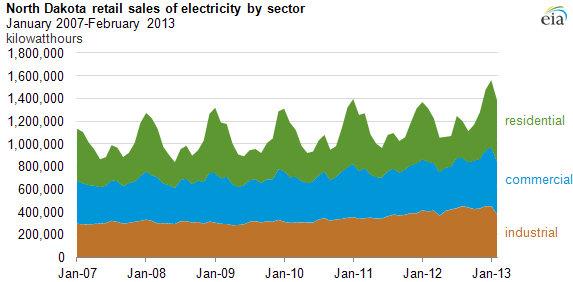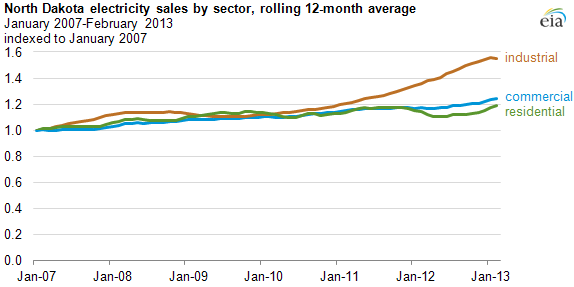Source: U.S. Energy Information Administration, Electric Power Monthly.
Note: Rolling 12-month averages are the average of the preceding 12 months of data, to adjust for seasonality in the volume of electricity sales.
Note: Rolling 12-month averages are the average of the preceding 12 months of data, to adjust for seasonality in the volume of electricity sales.
Increased oil and natural gas production in North Dakota has driven the state's growth in industrial demand for electricity. Rising economic activity and population in the state have also increased commercial and residential electricity use, although at a lower rate than in the industrial sector (see chart above). Crude oil production hasincreased significantly since early in 2007 because of the increased use of horizontal drilling and hydraulic fracturing in the Bakken Formation in the Williston Basin.
The amount of electricity delivered for end use in North Dakota falls into three main categories: commercial, industrial, and residential. In 2012, sales of electricity in the commercial and industrial sector each made up 35% of total sales, with the remaining 30% going to residential customers.
The volume of sales for electricity in the residential and commercial sectors typically peaks in the winter months in North Dakota as demand for electricity increases to heat homes and businesses. These seasonal fluctuations tend to be more muted in the industrial sector (see chart below).

Source: U.S. Energy Information Administration, Electric Power Monthly.
A recent study by the North Dakota Industrial Commission forecasted an 88% increase in total electric demand in the state between 2012 and 2017, mainly because of:
- Adding oil and natural gas wells
- Building and operating more infrastructure to support the oil and natural gas production (pipelines, water treatment facilities, gas processing plants, etc.)
- Growing population and employment
Two new oil refineries (large industrial consumers of electricity) are also planned or under construction in the state to process much of the crude oil production.
Residential and commercial sales of electricity also increased in recent months as more people have moved to the state and commercial activity has increased. All of these factors have led to a 41% increase in gross domestic product within the state between 2007 and 2011.
Source: EIA

No comments:
Post a Comment